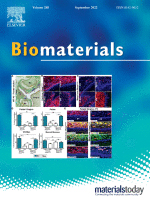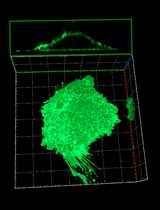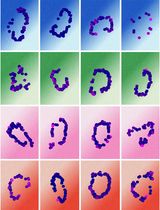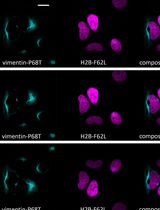- EN - English
- CN - 中文
Fluorescent Labeling and Imaging of IL-22 mRNA-Loaded Lipid Nanoparticles
IL-22 mRNA负载脂质纳米颗粒的荧光标记与成像
发布: 2024年05月20日第14卷第10期 DOI: 10.21769/BioProtoc.4994 浏览次数: 2711
评审: Agnieszka ZienkiewiczRiddhi Atul JaniAnonymous reviewer(s)
Abstract
Lipid nanoparticle (LNP)-based drug delivery systems (DDSs) are widely recognized for their ability to enhance efficient and precise delivery of therapeutic agents, including nucleic acids like DNA and mRNA. Despite this acknowledgment, there is a notable knowledge gap regarding the systemic biodistribution and organ accumulation of these nanoparticles. The ability to track LNPs in vivo is crucial for understanding their fate within biological systems. Fluorescent labeling of LNPs facilitates real-time tracking, quantification, and visualization of their behavior within biological systems, providing valuable insights into biodistribution, cellular uptake, and the optimization of drug delivery strategies. Our prior research established reversely engineered LNPs as an exceptional mRNA delivery platform for treating ulcerative colitis. This study presents a detailed protocol for labeling interleukin-22 (IL-22) mRNA-loaded LNPs, their oral administration to mice, and visualization of DiR-labeled LNPs biodistribution in the gastrointestinal tract using IVIS spectrum. This fluorescence-based approach will assist researchers in gaining a dynamic understanding of nanoparticle fate in other models of interest.
Key features
• This protocol is developed to assess the delivery of IL-22 mRNA to ulcerative colitis sites using lipid nanoparticles.
• This protocol uses fluorescent DiR dye for imaging of IL-22 mRNA-loaded lipid nanoparticles in the gastrointestinal tract of mice.
• This protocol employs the IVIS spectrum for imaging.
Keywords: Oral gene delivery (口服基因递送)Background
In ulcerative colitis, interleukin-22 (IL-22) plays a crucial role by promoting mucosal healing and regulating the inflammatory response. Lipid nanoparticles (LNPs) offer a targeted delivery platform for IL-22 in this context, effectively harnessing the cytokine's therapeutic potential to address mucosal healing and inflammation precisely at the site of injury [1]. Despite the increasing interest in utilizing LNPs for targeted delivery of therapeutic agents in ulcerative colitis, our understanding of their in vivo behavior is limited, hindering the clinical translation of LNP-based therapies. The tracking of LNPs in vivo can provide crucial insights into their biodistribution, migration abilities, and mechanism of action [2]. Therefore, the development of efficient and sensitive techniques for labeling LNPs is highly desired.
To date, several methods have been developed to unravel the in vivo dynamics of LNPs. Notably, the use of fluorescent dyes to label LNPs stands out as an effective approach for confirming successful therapeutic delivery. This highly sensitive and selective technique enables real-time monitoring and visualization of nanoparticle behavior and distribution in biological systems. However, a potential limitation of fluorescent labeling is the risk of dye leakage from nanoparticles in vivo, resulting in diminished brightness over time and the development of a background signal that may hinder accurate nanoparticle localization [3].
In a prior study, we engineered LNPs loaded with IL-22 mRNA for treating ulcerative colitis, evaluating the biodistribution of DiR-labeled IL-22/LNP [4]. In this protocol, we will describe the detailed process of labeling and imaging IL-22/LNP in the gastrointestinal (GI) tract using a fluorescent dye via the IVIS spectrum. In our previously published study [4], LNPs loaded with mRNA as described in this protocol displayed a distinct signal in the targeted organ (colon) and exhibited therapeutic efficacy.
Materials and reagents
Biological materials
C57BL/6J mice (Jackson Laboratory, female, 6–7 weeks of age)
Reagents
Curved feeding needles (Kent Scientific, catalog number: FNC-20-1.5-2)
1,1'-Dioctadecyl-3,3,3',3'-Tetramethylindotricarbocyanine Iodide (DiR') (Thermo Scientific, InvitrogenTM, catalog number: D12731)
Dimethyl sulfoxide (DMSO) (Fisher Scientific, catalog number: BP231-100)
Phosphate-buffered saline (PBS) (Corning, catalog number: 21-040-CV)
Laboratory supplies
15 mL conical centrifuge tube (Thermo Scientific, NuncTM 15 mL, catalog number: 339650)
Amicon® Ultra 15 mL centrifugal filter (Millipore, Ultracel®-100k, catalog number: UFC910024)
5 mL Eppendorf tube (Eppendorf, catalog number: 0030119401)
1 mL syringe PP/PE without needle (Sigma-Aldrich, catalog number: Z683531-100A)
Petri dish (CELLTREAT, catalog number: 229620)
Equipment
Micropipettes, 10–100 µL (Eppendorf, catalog number: 13-684-251)
Orbital shaker (CORNING, model: LSETM)
Centrifuge (Thermo Scientific, model: SORVALL ST-16R)
In vivo imaging system (PerkinElmer, model: IVIS Spectrum CT)
Software and datasets
Living Image software (PerkinElmer, IVIS® version: 4.7.4)
Procedure
文章信息
版权信息
© 2024 The Author(s); This is an open access article under the CC BY license (https://creativecommons.org/licenses/by/4.0/).
如何引用
Mow, R. J., Srinivasan, A., Bolay, E., Merlin, D. and Yang, C. (2024). Fluorescent Labeling and Imaging of IL-22 mRNA-Loaded Lipid Nanoparticles. Bio-protocol 14(10): e4994. DOI: 10.21769/BioProtoc.4994.
分类
分子生物学 > 纳米颗粒
细胞生物学 > 细胞成像 > 荧光
您对这篇实验方法有问题吗?
在此处发布您的问题,我们将邀请本文作者来回答。同时,我们会将您的问题发布到Bio-protocol Exchange,以便寻求社区成员的帮助。
提问指南
+ 问题描述
写下详细的问题描述,包括所有有助于他人回答您问题的信息(例如实验过程、条件和相关图像等)。
Share
Bluesky
X
Copy link












